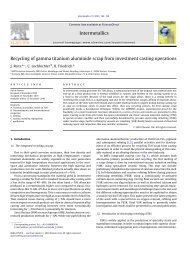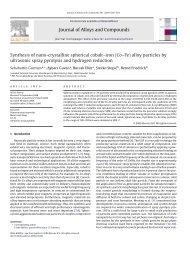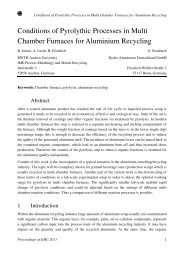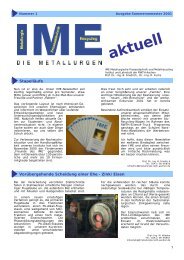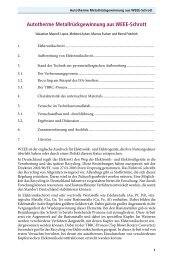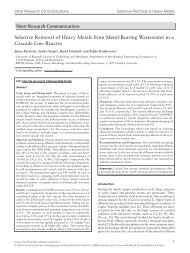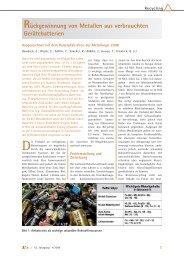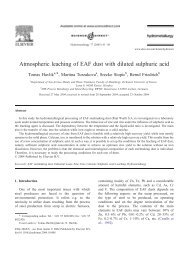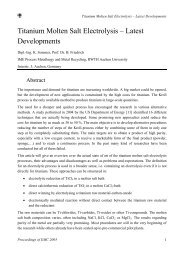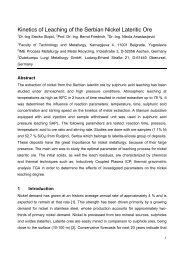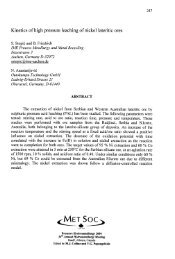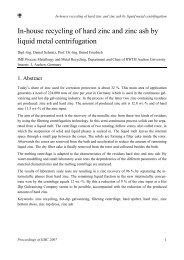Development of a Calculation Method for Recycling Efficiencies of ...
Development of a Calculation Method for Recycling Efficiencies of ...
Development of a Calculation Method for Recycling Efficiencies of ...
You also want an ePaper? Increase the reach of your titles
YUMPU automatically turns print PDFs into web optimized ePapers that Google loves.
<strong>Development</strong> <strong>of</strong> a <strong>Calculation</strong> <strong>Method</strong> <strong>for</strong> <strong>Recycling</strong> <strong>Efficiencies</strong><strong>of</strong> Battery <strong>Recycling</strong> ProcessesPr<strong>of</strong>. Dr.-Ing. Bernd Friedrich, Dipl.-Ing. Tim Georgi, Dipl.-Ing. Maik RidderbuschRWTH Aachen UniversityIME Process Metallurgy and Metal <strong>Recycling</strong>Germany1 IntroductionIn July 2006, the European Parliament and the EU Council <strong>of</strong> Ministersagreed on a compromise to revise the 1991 Directive covering batteriesand accumulators. The new Directive provides (inter alia) <strong>for</strong> recyclingand collecting targets to be reached by 2011 and 2012 respectively atthe latest. It has been set that any process <strong>for</strong> the recycling <strong>of</strong> batterieswill be obliged to reach a recycling efficiency <strong>of</strong> 65 % by average weight<strong>for</strong> lead-acid batteries, 75 % <strong>for</strong> nickel-cadmium and 50 % <strong>for</strong> otherbattery types. Due to various reasons the recycling efficiency <strong>of</strong> aprocess cannot be measured reliably, so that it has to be calculated. Butwhile the recycling targets have been fixed, it has not been defined howthe recycling efficiency is calculated. Up to now no agreement on acalculation method <strong>for</strong> recycling efficiencies regarding battery recyclingprocesses have been finalized. However the calculation method willhave a major impact on the battery recycling industry in Europe. Criticalpoints that have to be reflected by an equation are <strong>for</strong> example thedefinition <strong>of</strong> system boundaries, <strong>of</strong> battery elements and components to<strong>Development</strong> <strong>of</strong> a <strong>Calculation</strong> <strong>Method</strong> <strong>for</strong> <strong>Recycling</strong> <strong>Efficiencies</strong> <strong>of</strong> Battery <strong>Recycling</strong> Processes
e considered and those to be neglected, <strong>of</strong> assigning material values tothe input and output materials and <strong>of</strong> ensuring a transferability <strong>of</strong> theequation to all related battery systems.This paper is based on a study at IME Aachen with the objective todevelop a simple calculation method which can be applied to therecycling processes applied nowadays in industry and which does notfavour any processing route in particular. But the more simplified themethod is the more compromises are to be accepted as it will be shown.The method presented here is <strong>of</strong>fered as a discussion basis <strong>for</strong> theEuropean expert group <strong>of</strong> all stakeholders, which have to come to amutual agreement within the near future.2. <strong>Calculation</strong> Basis <strong>for</strong> <strong>Recycling</strong> <strong>Efficiencies</strong>2.1 Definition <strong>of</strong> <strong>Recycling</strong>Be<strong>for</strong>e going into details on recycling efficiency the definition <strong>of</strong> recyclingin the case <strong>of</strong> batteries has to be discussed. According to the EU BatteryDirective the recycling <strong>of</strong> batteries means the “processing <strong>of</strong> wastebatteries and accumulators <strong>for</strong> generation <strong>of</strong> products that can bedirectly reused in battery production or in other applications orprocesses”. The definition excludes the possibilities <strong>of</strong> disposal or energyrecovery. Un<strong>for</strong>tunately a repair and reuse <strong>of</strong> waste batteries isimpossible. Thus the only way <strong>of</strong> recycling is the recovery <strong>of</strong> valuematerials (not only metals). That leads to the question which kind <strong>of</strong>materials can be considered <strong>for</strong> the calculation. Waste batteries maycontain a lot <strong>of</strong> materials which were generated by different chemicalreactions during the use <strong>of</strong> the batteries. Those reaction products werenot present in new batteries and it is not possible to analyse all <strong>of</strong> them inthe battery scrap. Hence we propose to take only materials used <strong>for</strong>manufacture <strong>of</strong> new batteries into account <strong>for</strong> the calculation. Suchmaterials are metals, metal salts and oxides, carbon, plastics, electrolyte<strong>Development</strong> <strong>of</strong> a <strong>Calculation</strong> <strong>Method</strong> <strong>for</strong> <strong>Recycling</strong> <strong>Efficiencies</strong> <strong>of</strong> Battery <strong>Recycling</strong> Processes 2
or papers. An advantage <strong>of</strong> this method is that these materials are wellknownin composition and weight fractions because <strong>of</strong> the material datasheets that exist <strong>for</strong> all types <strong>of</strong> batteries.2.2 Key Elements <strong>for</strong> the <strong>Calculation</strong>For the proposed simple calculation method the following key elementsare set as the calculation basis <strong>for</strong> recycling efficiencies:1. prescribed recycling efficiencies apply <strong>for</strong> the average weight <strong>of</strong>the battery scrap2. all elements or compounds being present in new batteries that canbe captured and clearly identified in a product can be taken intoaccount3. elements or compounds originating from new batteries that arechemically or energetically used during the recycling process donot count according to the directive4. as reference <strong>for</strong> calculating the recycling efficiencies the mass <strong>of</strong>the waste batteries without humidity is used (according to the EUBattery Directive), not considering any plastic shells or electronicsfrom battery packs5. recycling efficiency is defined as the weight ratio <strong>of</strong> theacceptable “product fraction(s)” and the considered batteryscrap mass6. battery recycling processes may consist <strong>of</strong> multiple (sub)steps;each step is assessed individually and recovery values have to beadded7. any material produced during the entire recycling process thatcannot be considered as a product with regard to the EU WasteDirective is not accepted8. all produced elements and downstream compounds are to beaccepted by their full weight, if this element or compound wascomponent <strong>of</strong> the new battery<strong>Development</strong> <strong>of</strong> a <strong>Calculation</strong> <strong>Method</strong> <strong>for</strong> <strong>Recycling</strong> <strong>Efficiencies</strong> <strong>of</strong> Battery <strong>Recycling</strong> Processes 3
has to fulfil the prescribed recycling efficiency. This procedure may allows<strong>for</strong> economical optimisation, e.g. <strong>for</strong> the case that sub processes 2 and 3are more expensive than sub process 1. The case will be become morecomplex to control, if sub processes are run in different countries. In thisexample the black box recycling process fulfils the EU guidelines <strong>for</strong>fraction B, but the total input mix <strong>of</strong> waste batteries have to beinvestigated accordingly.2.4 Definition <strong>of</strong> ProductFollowing chapter 2.2 the recycling efficiency is defined as the weightratio <strong>of</strong> acceptable “product fraction(s)” and the considered batteryscrap mass. Thereby acceptable products should be defined as follows:• end-products or feedstock in other processes• materials not classified as waste with regard to the EU WasteDirective• materials independent <strong>of</strong> market value or final use2.5 The Specific Case <strong>of</strong> Water, Oxygen, Carbon and SlagWaterFor calculation <strong>of</strong> the recycling efficiency only the mass <strong>of</strong> the batterycell without humidity counts (s. EU Battery Directive, Annex III, DetailedTreatment and <strong>Recycling</strong> Requirements, Part A: Treatment), so water isnot considered at all.OxygenOxygen can only be taken into account <strong>for</strong> the calculation if it is part <strong>of</strong> acompound in an approved recycling product and this compound(<strong>for</strong>mula) was already present as component in the virgin battery (e.g.MnO 2 , NiOOH, LiCoO 2 …).<strong>Development</strong> <strong>of</strong> a <strong>Calculation</strong> <strong>Method</strong> <strong>for</strong> <strong>Recycling</strong> <strong>Efficiencies</strong> <strong>of</strong> Battery <strong>Recycling</strong> Processes 5
CarbonOnly if carbon is part <strong>of</strong> the new battery and is unchanged present in anapproved recycling product, it can be taken into account (e.g. graphitepowder, FeMnC…). So if a recycler extracts the carbon from the batteryscrap, it counts as product, but if the carbon is used in the process as areducing agent, it is not considered.SlagIf the slag is an approved product according to the EU Waste Directive(e.g. used <strong>for</strong> road or dump construction), the content <strong>of</strong> battery relevantmetal or metal oxides can be used <strong>for</strong> the recycling efficiencycalculation. But if the slag is declared as waste and described to landfill,it cannot be taken into account <strong>for</strong> the calculation <strong>of</strong> the recyclingefficiency.3. Battery <strong>Recycling</strong> Processes3.1 Fundamental DifferentiationsA variety <strong>of</strong> battery recycling processes exist which can be divided intopyrometallurgical and hydrometallurgical processes (s. Figure 2 and 3).Pyrometallurgical processes primarily aim on the high rate recovery <strong>of</strong>metals at high temperatures, but <strong>of</strong>ten with limited selectivity usingsmelting furnaces whereas hydrometallurgical processes aim on theselective recovery <strong>of</strong> elements or compounds at low temperatures bydissolving and precipitation, but typically with lower t/(h . m 3 ) rates). Somebattery recycling processes combine pyro- and hydrometallurgical stepsand <strong>of</strong>ten have pre-treatment steps like pyrolysis or mechano-physicalcell processing, i.e. crushing and material separation as shown in Figure 4.<strong>Development</strong> <strong>of</strong> a <strong>Calculation</strong> <strong>Method</strong> <strong>for</strong> <strong>Recycling</strong> <strong>Efficiencies</strong> <strong>of</strong> Battery <strong>Recycling</strong> Processes 6
Sorted Waste Batteries(e.g. Fraction B)Electric Arc FurnaceFlue DustSlagMetal / AlloyFigure 2: Example <strong>for</strong> a pyrometallurgical battery recycling processSorted Waste Batteries (e.g. Fraction B)Crushing / SeparationMetal,Plastics,Paper, …Black Mass (Metal, Metal-Oxides, C,...)LeachingInsoluble Oxidesand Metals,CarbonAqueous solutionPrecipitation and ReductionEffluentsMetal, CompoundsMnO 2, Zn, …Figure 3: Example <strong>for</strong> a hydrometallurgical battery recycling process<strong>Development</strong> <strong>of</strong> a <strong>Calculation</strong> <strong>Method</strong> <strong>for</strong> <strong>Recycling</strong> <strong>Efficiencies</strong> <strong>of</strong> Battery <strong>Recycling</strong> Processes 7
Sorted Waste Batteries (e.g. Fraction B)Company AMechano-physicalCell Processing(Crushing, Separation)Metal, Plastics,Paper, ...Black Mass (Metal, Metal-Oxides, C, ...)Company BWaelz KilnZnO-rich Dust (Concentrate)Company CZn ElectrolysisZn MetalFigure 4: Example <strong>for</strong> a battery recycling process that combinespyrometallurgical and hydrometallurgical process steps atdifferent sites (incl. pre-treatment)Besides utilisation <strong>of</strong> specialised battery recycling processes the addition<strong>of</strong> waste batteries to non battery dedicated large-scale processes (e.g.extractive zinc, cobalt or nickel metallurgy) is common practise and very<strong>of</strong>ten an economical advantage. This case has also to be considered bythe efficiency calculation methodology without making it too complex aseconomy besides ecology is a strong aspect <strong>of</strong> sustainability.<strong>Development</strong> <strong>of</strong> a <strong>Calculation</strong> <strong>Method</strong> <strong>for</strong> <strong>Recycling</strong> <strong>Efficiencies</strong> <strong>of</strong> Battery <strong>Recycling</strong> Processes 8
4. <strong>Calculation</strong> <strong>Method</strong> <strong>for</strong> <strong>Recycling</strong> <strong>Efficiencies</strong>4.1 Closed Loop TechnologyClosed loop technology means that the products generated within thebattery recycling process can be directly used <strong>for</strong> the production <strong>of</strong> newbatteries again. For closed loop recycling processes the calculation <strong>of</strong>the recycling efficiency (RE) is the simplest case, as RE is equal to theweight ratio <strong>of</strong> all approved products and the input battery scrap mass(s. Figure 5).m battery scrapProcessingWastem battery feedstock (products)RE total :mREbattery=mproductsbattery scrapFigure 5: <strong>Calculation</strong> <strong>of</strong> recycling efficiency <strong>for</strong> closed loop technology4.2 Open Loop Technology (Dedicated Process)Open loop technology means that the products generated within thebattery recycling process can be used <strong>for</strong> all kind <strong>of</strong> production orproduct manufacturing as feedstock materials. In the case <strong>of</strong> open looptechnology processes dedicated to battery recycling the recyclingefficiencies <strong>of</strong> each battery element (e.g. metal) and each compound(e.g. metal oxide) have to be considered. When an element orcompound X is contained in more than one product (s. Figure 6) the massfractions <strong>of</strong> X in every product have to be added and the sum is dividedby the input battery scrap mass. This leads to the recycling efficiency <strong>of</strong> X.<strong>Development</strong> <strong>of</strong> a <strong>Calculation</strong> <strong>Method</strong> <strong>for</strong> <strong>Recycling</strong> <strong>Efficiencies</strong> <strong>of</strong> Battery <strong>Recycling</strong> Processes 9
To calculate the total recycling efficiency all individual recyclingefficiencies <strong>of</strong> X, Y… have to be summed up.m battery scrapProcessingWastem ...product, Am product, BRE X :REXbatteryXXmproduct,A+ mproduct,B+ ...= mitmbattery scrapmXproduct,i= mproduct,i⋅ cXproduct,iRE total XY: RE = RE + RE ...battery battery battery+Figure 6: <strong>Calculation</strong> <strong>of</strong> recycling efficiency <strong>for</strong> open loop technology(dedicated processes)4.3 Open Loop Technology (Add to Process)If waste batteries are added to non battery dedicated large-scaleprocesses, a factor has to be introduced, considering that the batteryscrap mass is not the only input low <strong>for</strong> battery relevant element orcompound X. In this case simply the total input mass <strong>of</strong> X has to beadjusted by factor K whereas K is the weight ratio <strong>of</strong> X in the batteryscrap and the total input mass <strong>of</strong> X. Then the individual battery recyclingefficiency <strong>of</strong> X is equal to the ratio <strong>of</strong> mass fraction <strong>of</strong> X in the productand the input battery scrap mass multiplied by K. If more than oneproduct can be considered, the <strong>for</strong>mulas have to be extendedaccordingly as discussed in the previous chapter 4.2.<strong>Development</strong> <strong>of</strong> a <strong>Calculation</strong> <strong>Method</strong> <strong>for</strong> <strong>Recycling</strong> <strong>Efficiencies</strong> <strong>of</strong> Battery <strong>Recycling</strong> Processes 10
m batteryscrapm all other input materialProcessingWastem productRE X :REXbatterymXX= X productK ⋅mmit XbatteryK =XXbattery scrapmbattery+ mothersmRE total XY: RE = RE + RE ...battery battery battery+Figure 7: <strong>Calculation</strong> <strong>of</strong> recycling efficiency <strong>for</strong> open loop technology(add to processes)4.4 <strong>Calculation</strong> ExampleA calculation example <strong>for</strong> the recycling efficiency <strong>of</strong> a fictive batteryrecycling process is shown in Figure 8. The inputs are supposed to be200 kg waste batteries (dry weight) and 1000 kg other materials. Bothfractions contain iron, manganese, zinc and carbon amongst others.Hence the K factors <strong>of</strong> those elements have to be considered.The approved products <strong>of</strong> this fictive battery recycling process are 400 kgFeMnC alloy and 70 kg Zn dust concentrate. All elements <strong>of</strong> the alloy canbe taken into account <strong>for</strong> the calculation <strong>of</strong> the recycling efficiencyincluding the carbon because it is captured in a product. The Zn dustconcentrate contains zinc, manganese and iron amongst others. Thosethree metals can also be considered <strong>for</strong> the recycling efficiency, evenMnO 2 , if this compound is clearly proved <strong>for</strong> the dust composition. In ourexample we assume a different oxide structure (like Fe-Mn-Zn-spinell) andsuch none <strong>of</strong> the metal oxides are considered as they are nocomponents <strong>of</strong> a new battery. The iron, manganese and zinc content <strong>of</strong>the slag cannot be taken into account at all because in this example we<strong>Development</strong> <strong>of</strong> a <strong>Calculation</strong> <strong>Method</strong> <strong>for</strong> <strong>Recycling</strong> <strong>Efficiencies</strong> <strong>of</strong> Battery <strong>Recycling</strong> Processes 11
suppose the slag to be classified as waste. The total recycling efficiency<strong>of</strong> this fictive battery recycling process would amount to RE battery = 57 %.200 kg Waste Batteries (dry):- 40 kg Mn- 39 kg Fe- 37 kg Zn- 14 kg C- 70 kg Others (Oxides, ...)1000 kg Other Material:- 200 kg Fe- 150 kg Mn- 20 kg C- 0 kg Zn- 630 kg OthersProcessingWaste (with Fe, Mn,Zn not approved asproduct by EU)400 kg FeMnC Alloy:- 220 kg Fe- 160 kg Mn- 20 kg C70 kg Zn-Dust Concentrate:- 33 kg Zn- 10 kg Mn- 5 kg Fe- 22 kg OthersK i Fe 39kgMnZnC: K = = 0.16; K = 0.21; K = 1; K 0. 41239kgFemRE X FeFe product (220 + 5)kg: REbattery = K ⋅ = 0.16 ⋅= 0. 18m200kgbatteryMnZnCREbattery = 0.18; REbattery= 0.17; REbattery= 0.04RE total FeMn: RE = RE + RE + ... 0. 57battery battery battery=Figure 8: <strong>Calculation</strong> example <strong>for</strong> the recycling efficiency <strong>of</strong> a fictivebattery recycling processDue to the targeted simplification not all aspects and process details canbe reflected. The following examples may show some compromiseswhich have to be accepted:• If MnO 2 is contained in approved slag or waelz oxide products, itcounts as MnO 2 .• If slag is classified as product (non-restrictive <strong>of</strong> application), itcounts in all cases <strong>for</strong> the recycling efficiency.<strong>Development</strong> <strong>of</strong> a <strong>Calculation</strong> <strong>Method</strong> <strong>for</strong> <strong>Recycling</strong> <strong>Efficiencies</strong> <strong>of</strong> Battery <strong>Recycling</strong> Processes 12
• If carbon is extracted as product, separately sold and used, i.e. inor out <strong>of</strong> a battery recycling process as reducing agent or energysource, it can be taken into account.5. SummaryAccording to the new EU Battery Directive battery recycling must reachrecycling efficiencies <strong>of</strong> 65 % by average weight <strong>for</strong> lead-acid batteries,75 % <strong>for</strong> nickel-cadmium and 50 % <strong>for</strong> other battery types. But up to nowno agreement <strong>for</strong> the calculation method exists. IME Process Technologyand Metal <strong>Recycling</strong>, chair and department <strong>of</strong> RWTH Aachen Universityfinalized a study aiming on the development <strong>of</strong> a simplifiedmethodology. In this paper a procedure is proposed, which applies <strong>for</strong> allbattery types and all recycling processes. The outcome <strong>of</strong> the work canbe summarised by the following statements:• The proposed calculation method is based on relevant elementsand compounds which exist in new (virgin) batteries and not onthose being present in the scrap. Humidity, plastic shells andelectronics or connectors are not considered.• Battery recycling processes may be based on single or multiplesteps plants. Three principle types <strong>of</strong> recycling processes exist:1. closed loop technology (battery to battery)2. open loop technology (dedicated battery recyclingprocesses)3. open loop technology (add battery scrap to volume <strong>of</strong> scaleprocesses)• Materials are products, if not classified as waste with regard to theEU Waste Directive.• The calculation may end once products are created, which canbe used as feedstock <strong>for</strong> other processes or are individual endproducts(independent <strong>of</strong> market value).<strong>Development</strong> <strong>of</strong> a <strong>Calculation</strong> <strong>Method</strong> <strong>for</strong> <strong>Recycling</strong> <strong>Efficiencies</strong> <strong>of</strong> Battery <strong>Recycling</strong> Processes 13
• Each relevant element or compound is considered <strong>for</strong> thecalculation; the total recycling efficiency <strong>of</strong> the battery recyclingprocess results in the sum <strong>of</strong> these element/compound specificrecycling rates.• Simplification leads always to compromises, but in this specific case<strong>of</strong> battery recycling efficiency they have a very small impact on itsfinal value.• The battery recycling procedure may be split up to various (sub)processes and countries in order to reach economy (averagerecycling efficiency).This methodology was developed to stimulate the discussion betweenpolitics and battery producers/recyclers as well as their associations inorder to find a mutual and long term stable solution <strong>for</strong> calculating thebattery recycling efficiency. The authors do not intend to assess ordiscriminate existing processes with this proposal. But we have usedpublished data from the recycling sites <strong>for</strong> validation <strong>of</strong> the model.Besides some minor compromises to be accepted the method workedwell and lead us to the decision <strong>of</strong> publication. We thank all discussionpartners from industry and administration <strong>for</strong> their fruitful input.<strong>Development</strong> <strong>of</strong> a <strong>Calculation</strong> <strong>Method</strong> <strong>for</strong> <strong>Recycling</strong> <strong>Efficiencies</strong> <strong>of</strong> Battery <strong>Recycling</strong> Processes 14
LiteratureRombach, E.; Friedrich, B.; Berger, M.: “<strong>Recycling</strong> Efficiency <strong>of</strong> thereprocessing <strong>of</strong> primary batteries”; in: International Congress <strong>for</strong> Battery<strong>Recycling</strong>; Interlaken; 28.-30. June 2006.Sanchez, R.; Friedrich, B.: „Primärbatterien besser recyceln“; <strong>Recycling</strong>Magazin; vol. 60 (2005) no. 23; p. 18-19.Sanchez, R.; Friedrich, B.: “Optimization <strong>of</strong> the FerromanganeseProduction from Spent Primary Batteries – Design <strong>of</strong> the Process Slag”;World <strong>of</strong> Metallurgy – ERZMETALL; vol. 60 (2007) no.1, p. 7-14.Rentz, O.; Engels, B.; Schultmann, F.: „Untersuchung vonBatterieverwertungsverfahren und –anlagen hinsichtlich ökologischer undökonomischer Relevanz unter besonderer Berücksichtigung desCadmiumproblems“; Umwelt<strong>for</strong>schungsplan des Bundesministers fürUmwelt, Naturschutz und Reaktorsicherheit; Forschungsprojekt 299 35 330;Universität Karlsruhe (TH); Deutsch-Französisches Institut fürUmwelt<strong>for</strong>schung; 2001.Fricke, J. L., Knudsen, N.: „Entsorgung verbrauchter Gerätebatterien“;GRS – Stiftung Gemeinsames Rücknahmesystem Batterien (Ed.);Hamburg; 2002.Henrion, P.: “Battery recycling – A perspective from a Nickel and Cobaltproducer”; in: International Congress <strong>for</strong> Battery <strong>Recycling</strong>; Como; 02.-04.June 2004.Trueb, L. F.; Rüetschi, P.: „Batterien und Akkumulatoren“; 1. Edition; Berlin,Heidelberg, New York; Springer Verlag; 1998; ISBN 3-540-62997-1.Baumann, W.; Muth, A.: “Batterien – Daten und Fakten zumUmweltschutz“; 1. Edition; Berlin, Heidelberg, New York; Springer Verlag;1996; ISBN 3-540-61594-6.<strong>Development</strong> <strong>of</strong> a <strong>Calculation</strong> <strong>Method</strong> <strong>for</strong> <strong>Recycling</strong> <strong>Efficiencies</strong> <strong>of</strong> Battery <strong>Recycling</strong> Processes 15



